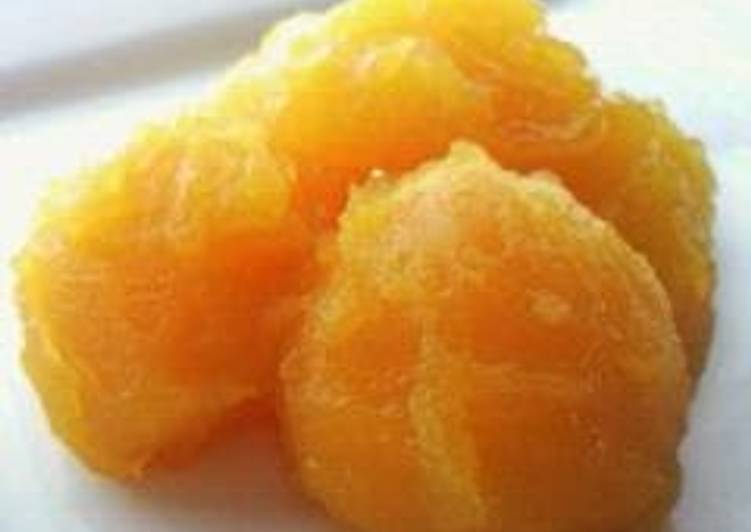Our Family Version of Kuri Kinton (sweet potato puree with chestnuts) for Osechi. Great recipe for Our Family Version of Kuri Kinton (sweet potato puree with chestnuts) for Osechi. If I have any leftovers, I bake a cake and use this as a Mont Blanc style cream on top. Kuri Kinton or Candied Chestnuts and Sweet Potatoes are a special Japanese New Year dish, which symbolizes economic fortune and wealth.
 Our Family Version of Kuri Kinton (sweet potato puree with chestnuts) for Osechi If I have any leftovers, I bake a cake and use this as a Mont Blanc style cream on top.
Our Family Version of Kuri Kinton (sweet potato puree with chestnuts) for Osechi If I have any leftovers, I bake a cake and use this as a Mont Blanc style cream on top.
White kinton macadamia: Kuri kinton (candied chestnuts with sweet potato paste) literally means 'chestnut gold mash' and symbolises economic fortune and wealth.
You can cook Our Family Version of Kuri Kinton (sweet potato puree with chestnuts) for Osechi using 9 ingredients and 9 steps. Here is how you cook that.
Our Family Version of Kuri Kinton (sweet potato puree with chestnuts) for Osechi If I have any leftovers, I bake a cake and use this as a Mont Blanc style cream on top.
Our Family Version of Kuri Kinton (sweet potato puree with chestnuts) for Osechi If I have any leftovers, I bake a cake and use this as a Mont Blanc style cream on top.
White kinton macadamia: Kuri kinton (candied chestnuts with sweet potato paste) literally means 'chestnut gold mash' and symbolises economic fortune and wealth.
You can cook Our Family Version of Kuri Kinton (sweet potato puree with chestnuts) for Osechi using 9 ingredients and 9 steps. Here is how you cook that.
Ingredients of Our Family Version of Kuri Kinton (sweet potato puree with chestnuts) for Osechi
- You need 200 grams of Chestnuts in sugar syrup.
- Prepare 200 grams of Syrup from the chestnuts.
- It's 200 grams of Sweet potato.
- You need 2 of packs Dried Gardenia seeds (for the yellow color).
- Prepare 2 tbsp of ●Water.
- Prepare 30 grams of ●Sugar.
- It's 2 tsp of ●Starch based sweet syrup (sugar syrup).
- It's 2 tsp of ●Mirin.
- It's 1 pinch of Salt.
Usually the sweet potato paste creates the golden colour, but this recipe uses white lupin beans for the paste, combined with whole roasted macadamias. KURI KINTON is chestnuts in mashed Japanese sweet potato, and it requires lots of work to make this, so I modified that time. My mom always sweats a lot when she makes this, and she get sore arms the next day. KINTON's KIN means gold, so this implies our hope to have abundant fortune in the coming year.
Our Family Version of Kuri Kinton (sweet potato puree with chestnuts) for Osechi instructions
- Take 100g of the chestnuts in syrup and 100g of the syrup itself, and puree into a paste in a food mill, blender or food processor..
- Peel the sweet potatoes and slice into rounds. Soak in water to remove any bitterness. If you have little more sweet potato than the amount in the recipe, it's not a problem..
- Put the soaked drained sweet potato into a pot with water to cover. Add the gardenia seeds, and boil until the sweet potato is tender..
- Drain step 3 in a sieve. Remove the dried gardenia seeds, and pass the sweet potato through a sieve to puree..
- Put the sweet potato puree into a pan, and add 100g of the chestnut syrup and the ● ingredients. Start heating over low heat..
- Cook the puree down till it thickens. Sprinkle in the salt to finish, and take the pan off the heat..
- Add the chestnut paste from step 1 into the step 6 puree and mix. If it's still too soft, heat it back up for a bit more..
- Optionally add about 100 g of whole chestnuts in syrup, and the kuri kinton is finished..
- Mix the leftover kuri kinto with whipped cream to make a delicious chestnut cream. Use on Mont Blanc cakes and more..
Osechi foods typically have a symbolic meaning. For example, on New Year's Eve, a dish called toshikoshi soba (年越し蕎麦), or "year-crossing buckwheat noodles", are eaten to bring good luck in the coming year. The noodles symbolize vitality, health, and long-life. They are also practical because traditional wives who were busy cooking several days. Osechi-ryōri (御節料理 or お節料理) are traditional Japanese New Year foods.